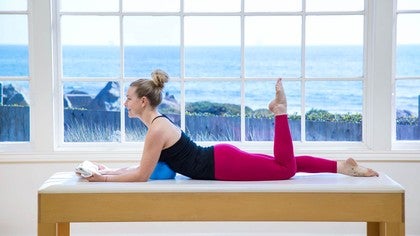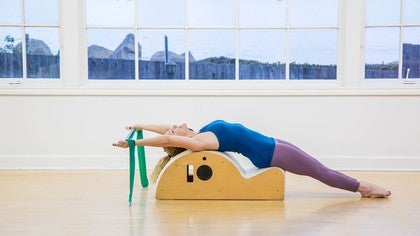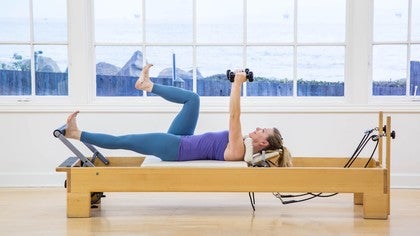Description
About This Video
Transcript
Read Full Transcript
Hi, everyone. I'm here for a wall unit workout and the demographic that I'd like to have focus on for this class is kind of aging people that are still very able to do a lot. But maybe you're not as mobile in your lower back and rolling exercises aren't as fun as they once were or maybe you're just not even in that category to begin with. For teachers that are working with clients like that, this is great for quote the active aging population. So I'm looking at some functional movement in this class but daily living activities that we want to keep vital and alive.
So shoulder flexion, mobility in the spine to a relative degree, leg strength, gait, some foot strengthening. So a lot, right? So just daily living and being very vital. So what we're gonna be working with as far as the set up, you'll have your roll back bar but you'll also need some handles. I'll show that when it gets there.
The strap that, I'm on the raised wall unit mat but you can use a strap from the reformer foot strap or at the end of the raised mat tower mat strap or any kind of breathing, like the breathing sling. I think balanced body makes one and then a foam roller. So get those props ready. There'll be some set up back and forth between the bar and the handles along the way so just know that that's coming. But go ahead and round up your things and meet me back on the mat and we'll get started.
I want us to set up the tower first here. So you take your roll back bar setting. We're not gonna use it in the normal way mostly at all today. And I want you to go and put it all the way down at the bottom. So I'm using the very bottom floor mounted eye bolts and then just get that set and set it down for a moment.
Grab your foam roller and put it down. We're gonna stand on this to begin with and warm up our feet. Okay, so this class also involves some standing balance and I think it's very important to begin with the feet and warm up the proprioceptor. Get your antenna, your feet antenna tuned up. And I'm just gonna start facing away from you so I don't have to turn my head.
Get yourself organized, nice sense of alignment. You can look down, get your feet underneath your pelvis. Nice elongation through the top of your spine. And just sense how your weight distribution is on top of the roller. If there's a way you can build the idea that you're lifting your arches up, you're lifting your leg muscles up into pelvis.
Your lumbar spine up high and out the crown of your head. Let's just take two breaths. Lateral posterior breathing is big focus today. I'm gonna keep our back nice and hydrated. Okay, keep breathing in that way but guys we're gonna start moving up the ankle joints, very small movement to begin with.
So I'm working on dorsiflexion and plantarflexion. Just a little bit, ankle movement. Okay. So right away you're sensing your standing balance a little challenge because we're moving on this roller. Don't fall off but go back far enough or toward the balls of your feet that you get a satisfying stretch in your achilles tendons, your calves or feet.
And when you go the other way, be mindful not to come too far, I don't want anybody to fall through the frame. Hold on. But notice the movement is really at the ankles and not the pelvis or the arms. All right, so everything from ankles up is in place. The moving joints are the ankles and the feet.
It should feel pretty good. You may have one bottom foot surface that is tighter so it's kind of a little shiatsu massage for your feet. Let's do two or three more. And as you're moving forward and back, still work on axial elongation or that thought of not settling down into any of your joints at all but standing up tall. Maintaining your height.
No one wants to get shorter as they age anyway. So let's work on staying tall. Okay guys, we're gonna take one more and feel free to add this in your daily program no matter what your exercise is. It's very healthy for your feet to do. All right, keep the foam roller nearby.
We'll need it near the very end but go ahead and step back off and let's just set it off to the side. I'm just gonna set mine all right back there. Okay and then I'm gonna face you now for this. Let's just do a little bit of releve or coming rising up onto the balls of the feet and down. And getting a little different sense of balance challenge.
If you're holding your wall frame, you can use it one index finger maybe. And just getting some movement now at the metatarsals. I'm gonna go into a tiny bit of walking in place. Really work to bend the toes. You'll need this in a little while too.
I'm just gonna do four and three, two, one. Just a few more. All right, then we're gonna turn and face the wall unit. Standing a little, working a little different loading principles. Okay, bone loading and body loading.
So I want you to grab at that dowel. Lift up those springs. Make sure your eye bolts and spring attachments are nice and straight. Okay, hands on the outside of the eye bolt frames and step back and let's get ourselves in a hip hinge position. So if you're not sure what your hip hinge is, you can refer back to any of my classes in active aging program.
Rebecca Rothstein, Erika Quest, Sherry Betts, Madeleine Black, a lot of us teach this. Bending your knees and you're moving right at your hip joints. You're in an extended spine. All right, so a lot of this population, we really want to get out of this posture if you're watching this doing it yourself, right? We want to lose that curve and that roundness.
If you're a teacher get those shoulder blades back on your clients back. Get them back there, okay? So I want you to lower your spring weight. You're in your hip hinge so it's pretty soft right there. Take a deep breath.
As you exhale, ground your heels into the mat. Contract your glutes and pull those springs up towards your legs. Little glute squeeze and a shoulder press. Let's do about three slow, just so you can get the pattern and sequencing. So heels ground.
Your legs engage. You're basically pulling the weight up from the ground to your body. And descend. So I'm starting a very modest challenged position here as far as how far away from the tower. If you feel like you want more challenge, most of you know you want to stretch those springs out more so step back, I'm going to show three more that way.
Okay just know that the load is greater here. So deeper hip hinge, deeper work in your back. Now, it's not the shoulders need to come down your back so much. Energy up the upper spine and head. Breathe in, ground your feet, pull the springs.
Release the springs. Pull the springs. There's load and effort in both directions here. How you lower your weight and how you bring it up from the ground. How would this be functional?
Right, think about that. Daily living, picking up a box from the ground. Picking up your animal, a little puppy or your dog, your grandchildren, your suitcases, grocery bags. All right, do it from a hip hinge. I know I said three more and I added three to that so nine, may as well go to 10.
Press those legs and pull your weight up. Now, hold this position. So regular Pilates chest expansion is kind of where we're at. Pull the bar against your legs. Let's see if you can rise and lift your heels a little bit.
This is not easy because those springs are wanting to pull me forward so I need to oppose and keep the springs stretched. How I'm doing that is pulling the bar. Yes, some arm muscles but a lot of spine. Trying to stay tall. Let's go a little bit faster.
So some of the training we like to work on in our population or the active aging population is changing tempo, changing velocity. Not always doing things at the same time. Let's stay. Or the same rhythm. And you're going to trick your body sometimes.
Little slow prances and let's pick it up. Keep those springs pulled against your body. Four, three, two, and one. And release. Now we need to let go the springs.
Come through your hip hinge and release. All the way, okay? So now, here's what I mean. We're gonna be changing this bar out for the handles kind of a few times in class. Keep it nearby.
All right, put on your handles. So these handles clip a right on. We're gonna do the same exercise. It's gonna feel different because you have independent motion potential and if you have a dominant arm, it may want to start you but try to do it uniformly first. Okay.
I will say let's do five or six reps. Same thing, here we go. Get yourself organized with your shoulders on your back. Deep hip hinge, deep breath in. Start at the heels.
Then the legs, the hips, and just pull. Release. Heels drive in. Pull. So some of you teachers that are watching might be seeing some posterior slings.
There's going to be anterior oblique sling. A lot of that going on in class. Three more. Try to keep them moving even with the springs. Okay.
So kind of moderate challenge. Now, I want you to drop one, the right side. Use that right hand, put it in the left spring and step back into a kind of a lunging setup here. Okay. So do what you can, hip hinge on that single leg.
Stretch your back leg, other hand on your thigh, and just feel that. So there's a little bit of upper body rotation. Don't want you to turn so much but think about the front leg right now. Put your mind there. Press that heel into the floor.
Start to bring your body upright. It's the heel and it's the right lat working with your left glute here. And then return, lat and glute. Okay, front leg initiates. You press down, pull your body up, you can bring your elbow back, not too far.
That elbow really shouldn't go too far behind your back anyway. Upper arm control. Three more like this. Use your focal point, your eyes, walk your eyes up the wall. Now, if you don't just have your back leg completely straight, that's okay.
Some of you might be noticing I'm not straight. I want you to notice that that is fine. Completely straight is fine. What's more important is your balance and if you have any foot issues, that's hard enough just to be back on that foot like that. Bending the knee is going to help your balance a little bit.
So do what you can. I'm pretty impressed that I didn't fall off the mat right there. Okay, let's add on to that. And so starting the same way. Press your front leg, down pull your body up, and add some torso rotation.
Okay, you do not have to pull your arm any further behind you. It's really about your upper body, your thoracic spine moving into rotation. I'm going to do six of those, here's three. It's okay to use your eyes so look a little further around. Try to be very steady on the front leg and your back foot.
Here's four. Do one more, two actually, five, six. And hopefully you're feeling the work in the front leg like I am. All right and lower the weight down. Okay, change sides so reach down pick up that second handle.
Front foot, lunge back. Get yourself relatively even weight between both legs to start. Again, I'm going to keep my back leg a little bent so I can get really well-balanced on that foot. Hand on your thigh. Control the weight of the springs down.
Adjust your pelvis, here we go. If this heel presses down this glute starts to pull you up. Your back muscles initiate and you pull the strap. Or the spring. Front heel, front leg.
Your back. Control the weight. You're pulling something up off the ground. You're carrying it around. You need to lower it down to the ground.
Safely, three more times. Feel the front leg initiate, that's their standing leg. That's your power leg in a way. Two more here and then we'll add that thoracic rotation. Last one.
I'm gonna go right into it. So once you stand up then you turn, think about turning through your chest bone. And control the weight down. Front heel, turn from your chest bone. Now, my back leg, even though my knee is a little bent, I still want my glutes engaged to steady my pelvis on that side.
Last two. So we're not over pulling from the elbow or from the shoulder blade. It's thinking about the spine and notice that is also really nice for functional movement like walking. Having a good gait stride. Okay, hope you're feeling good and getting warmed up.
We're gonna be doing some things turned this way and I want you to move the springs now. So unclip from the bottom. We're going to bring them about shoulder high and we need the wooden dowel again. So we're coming back around. Keep breathing as you move.
Keep the handles nearby, we'll use them shortly. Climb on in, hands on the outside. Now, depending, I'll just do that. Depending how your shoulders feel and how your balance is, you'll know how far away from their frame you can go. So this is, where I'm at now is very easy for me.
I'm gonna challenge myself by coming out just a little bit. Now, as you start to raise the bar, maybe you can start it at your hairline level. And lean, pull on the springs. Now I'm not leaning my chest only and I'm certainly not leading just with the pelvis. Your whole trunk really.
Okay, maybe you just start there for a moment. See if you can get organized with your alignment. Now, let's see if you add some elbow extension. And elbow flexion. Let's go for five.
So the upper arms stay in the same place externally rotated. Make sure the ribs aren't getting greedy and shoving themselves forward or thrusting forward. You want to keep good rib control here. Okay, one more. There's our five.
Now, I'd like to add more shoulder flexion so I want to start to raise my bar up but it's really coming from the movement of my scapula in upward rotation. Starting to shake a little, this is really nice. I'm gonna just hold this position and see if you can let this spring start to pull your arms back a little bit but you're controlling and not just letting it go. Let me regroup. Just to show you what that potential is.
Be mindful, stay and control of those springs. So I'm going to let my shoulder blades come up a little bit in to upper rotation. Letting the upper trapezius melt down and try to use those mid and lower trapezius muscles. Holding there. Can you lean a little more?
Let's just hold for three more breaths. Sometimes isometric work is just as important as bigger movement. Upward rotation of the scapula. How do you get out of that, I would bend your elbows and soften the springs. You can stay with that, if you'd like to but I'm going to clip out and get the handles again.
And we'll be using the handles for quite a bit next. So today's class is you can kind of see the little more upper body focus. And balance. Here we go. Same thing.
Must feel what it is with the separateness of the springs. So again, might look like salute. Might, it's not really gonna look like salute. So I'm going to mimic holding that bar. And let's do five again, elbow extensions.
And one. Control the return. Upper arms externally rotated. Ribcage in. Three.
And four. It feels a little different here and five. Now, if we go into shoulder flexion. Can you time it at the same time? The bar was useful to get the timing correct and even but when you've got the unilateral or the independent movement work to keep them the same, okay?
Until we don't, which is right now. I'm gonna have you do a little standing swimming. So what's working more? The pull forward or the return back? I don't know the answer.
For me both sides are working pretty evenly. Want you to start allowing a little freedom in your thoracic spine, ever so slightly letting it rotate. Not the pelvis. Let's go a little bit faster. Less tension in your muscles.
Feel how those springs are nice and buoyant. Let your let your joints have that too. Four. Three. Two.
And one. And relax. So I'm hoping you're feeling a lot of work in your upper back because you were standing nice and tall, I'm pretty sure you were. Turn to face the frame now and I would like us to stay where they're hooked but you're going to need to cover more area, stepping back a little further. You'll know in a minute.
I don't want anybody to step off the mat of course but can you step back with one foot and go into what would be almost like a marriage proposal position. Okay and then come back up with your knee. If you can't go that far with the back leg going all the way like I'm doing, knee down. That's okay, go to where you can. I'm gonna go with eight of these everybody.
So holding this spring is giving me a little bit of support. Bending those toes again. If you wanted more support, what would you do? A couple of things. You could put the the spring mounts all the way up to the very top of the frame.
You could pause and get different spring strengths. Or just endure it. Here we go, hold it now like this. And let's do eight little pulls. Use your upper back.
Use your lats. Keep bending those back toes. Elbows will not go behind your back you guys. Six. Seven.
And eight. And then center. Other side, stepping back with the second leg. Here we go. Now, take your time on the first one.
See where you need to be. Feel where you need to be. Can you get your knee down? And knee up. Knee down.
Knee up. Find something right in front of you to look at, a focal point. It's your visual system, very important in balance work. Four more but your front leg is really the focus leg. Helps you descend to lower your weight and you use it to stand up.
Last two. Last one, we're going to stay. Eight more. One, they don't have to be as big. You can also do this way down here if you're feeling okay.
It's that upper back. Imagine balancing a yoga block on your head maybe. Trying to get it up on the ceiling a little more. It's a lot of axial elongation, last two. And last one.
And then recover. Come a little closer. I'm gonna make a change here for my own body. I like chest expansion to go, I like my springs lower for me. And why?
So that I don't start to pull the spring from above my shoulder but more below. Yeah, all right. Let's just stand in a slight Pilates V. Spring is by your side, super important exercise for every person I think around. Lengthen the arms, pull the springs back.
Let's just do five or six basic ones. No head turn yet. Long arms reaching back. So in ways to challenge our balance, you could do this with your eyes open or closed. You can't tell if I'm closing my eyes probably but I just closed them.
Maybe you can but if that feels very unsteady for you, please don't close them, I don't want anyone at risk feeling like they're going to fall. Now, pull the springs back and hold them. Let's stretch our neck. Look over one shoulder. Turn and look over the other shoulder.
Maybe not just over the shoulder but behind your shoulder. Look center. Release. Pull, head turn. Head turn.
Center. Two more, start turning the other way with your eyes, first in your neck. Are you standing tall? Keep those ribs controlled. Keep your abdominal muscles in.
Okay, we're gonna build on that everybody. Step back a tiny bit. Still in a Pilates V. That may help your balance because you can use your hips and your legs to wrap around your legs there. Pull the springs and rise up onto your toes.
Lower the springs, lower your heels. I'm going to exhale. So this is some amazing balance work. I think it's really fun. Try to time it, that you're arriving in your arm pull and heels up as high as you can, all in one movement.
You lower in one. And. And. Pull the springs and pull your body up. Change it to parallel, let's just do four.
How we doing? Hopefully everyone's trucking along. Down to go back with those arms. Three. Let's stay up on four.
Stay there. Now, if you want a lot more challenge try to turn your head one time just over your shoulder. Your arms are still pulled, you're still up in a releve. You're tall. Whoa, I didn't lose it.
I'm gonna take a little walk in place. Pull those springs. A little faster, eight. Seven. Six.
Keeping those shoulders extended, broad chest. Upper spine length, two. And one. Holy Mamuh. Shake your arms out.
Let's make a change and we'll take off the handles. We're going to put on the straps. So again, this strap I'm using was at the end of my mat over there. You could certainly use it with the fuzzy from your reformer if you have that on there. So take off those handles.
Yeah. We may get back to them. Maybe not. And then all I'm doing is just clipping those in. If you have a balanced body breathing sling, that would be really nice to use here.
I'm just going to use the strap. Make sure it's not twisted. And we are going to do just a standing lateral posterior breathing. Something nice and calm after a lot of that bigger movement. So stand facing your springs.
You want that sling or the strap, not in your lumbar but up at the bottom of your ribs, base of your shoulder blades actually. Kind of in between those landmarks. And step back. Enough that you're already on stretch of the springs. Just a little softening of your knees so you're not locking those.
Now. Glance at your springs and we'll do maybe five or six breaths as you take that big generous breath in, I want you to pull those springs towards you. And exhale. Let them go away. So the more we expand lateral posterior, that's what's going to really feel the tension, the positive relative tension.
And exhale. Keep long in the abdominals. And exhale. So if you feel like one side moves quicker than the other side, what do you think you should do? Focus on the one that's not moving as much, here we go.
Some breath and coordination. Two more. Lateral posterior breathing. Filling up the back rib space. I love that.
Ready, turn around now. Put it again at the base of your ribs. Not on your navel, definitely not up at the xiphoid but somewhere in between. And walk out far enough that you feel like it's a little challenging to keep walking. That's what's coming next.
I want you to take one foot and put a heel forward. Just that will probably challenge your sense of being upright and steady and just hold that. Lot of flexion here. I want the front of that shin nice and contracted, pull those toes up. Now, it's the standing leg, the back leg.
That knee is not going to bend. Don't bend it. Push the ball of the foot down into the floor and try to take a little step. Push. Now, control how you go backward.
Push to walk. This is the kind of feeling we should have when we walk around the world. The sense of being able to push off and use that back leg hip to move forward. Are you feeling that when you walk, probably not. Maybe.
Do whatever make sense in your arms right now. See if you can find a little bit of a rhythm. Push and move, control how you go back. Push and move, control how you go back. So it's that back foot.
Foot, calf, hamstrings, glutes. A little faster. Still in control. Really whoa, that wasn't a good example. So you might want to think of lifting up the entire time, right?
All that lengthen up, if you compress down, most likely your balance is going to drop. And you might lose yourself and fall. And let's change sides. I have no idea how many that was. That's the way it goes.
All right, one side is always more coordinated. Flex that foot. Take a moment. The back leg is strong, the knees are straight. You've got everything pulled together.
Now, the front foot there, plant the foot but it's the back leg. Shift yourself and push the foot down. Control how you return. Push to move forward, lift to control. Backs a lot of eccentric work.
Oh, in the front foot and the back hamstrings. Starting to get a little rhythm. Push to move forward. Push to move forward. And I think I found it.
So I haven't really mentioned yet too much about the inner thighs but they're working. I'm trying to keep those muscles toward my midline center. Found a groove you guys, here we go. Let's try to speed it up a little bit if you can. Push, return.
Push, return. Feeling the back glute. Push, let's go with four more. Push. So if you had to run out of your studio or out of your workout space right now, you'd be able to because you're propelling yourself forward.
Whoa. And propelling yourself forward and rest. Hmm, that's so much fun. We're gonna go down into what would look like a downward dog. If you do yoga, maybe use that idea.
Here it is. The strap is going to be right at your hip creases. Walk yourself down and out into your hands. If you don't like being on your hands like this, you could certainly come all the way down onto your elbows but we're gonna do something like that in a little while. So see if you can hang out here for a bit.
Index finger pointing to the top of your mat. Let your head go between your arms a little bit. Now again, if that doesn't feel like a lot of support or even use of the springs and you want to feel more, walk out. That feels better to me because the springs are kind of pulling me back, I'm going to let them help me get that hip crease and hamstring stretch. It's okay if this is you with your knees bent, that's fine.
Can you lift your sit bones? Can you get your head down a little more? But watch my shoulder blades, see how I've dropped them here. That's not what I want us to start with. Go the opposite way.
So just like we were standing earlier before the standing swimming, shoulder blades toward fingers. Now, let's focus on the scapula, those shoulder blades. Glide them. Glide them. Glide.
Glide. Chest drop. Push the mat away. Scapular glide, trying to deepen your awareness of that upper middle spine. Postural muscles.
Three more everybody, we've got this. Push away. Really push long. Two more. Okay, it's gonna get a little bit harder.
If you want to try you can even just stay with those. Now can you flex your elbows and extend your elbows. Tricep strength. Your upper arms need to be in external rotation. These are harder, as far as muscle focus.
Glad that harness is there on my hips, helping hold my body weight up. Here's four. Two more. A lot of thoracic length. This is better, five.
And six. Walk yourself back. Walk yourself up. Slow and steady. How'd you do, feel okay?
We're gonna move on. Take yourself out from underneath here. We're gonna sit down on the mat now and this will be a little interesting. I think I would like us to move the springs down one notch. Yeah, bring the handles back in and they'll also go on where the strap is.
So you're gonna have a strap and a set of handles on the same hook like that. I think the choreographer in me likes to create things like this but it's functional, trust me. Great. So it's an interesting setup here. Strap, handles, and yes you're gonna work with your bar.
It all makes sense. It's kind of fun and it's different. so let's do this everybody. Take your knees and put them over that strap. Scoot a little bit forward.
Bring your bar with you. This is fun. So again I'm playing with the springs here, similar to the last exercise with that traction sense. It's kind of pulling me forward. What do we have to do to avoid that, a little bit of connection is opposing that abdominals.
And some hamstrings. So I want more challenge then. I want more feedback, I should say it that way. And go back, yeah. All right.
With your dowel, I want you to start first with your dowel right on your thighs. Your wrists long, okay no flexion in the wrist or extension or any of that motorcycle riding thing. And just hold. We've done a lot of upper back work, a lot of chest expansion, shoulder work. So you've got that organized, let's take a breath.
Lateral posterior and go with your pelvic tilt. And reach your thighs up toward the roll back bar. Really press. Breathe in, let's just do two plain pelvic curls. So I said at the very beginning of class, if you're in your body that your back is starting to stiffen and rolling exercises aren't as fun anymore, we're not going to do a lot more than what you're doing now in articulation.
It is important to keep hydrating the back this way, even if you feel stiff, keep trying and practicing it. And teachers that are watching, definitely keep your clients doing it. We need to, all right. So there we are. Now, reach your arms straight above your shoulders.
Notice the bar is very level. Hopefully not this way, right? So really level and unroll your spine. We'll do a couple more with your arms straight up. So a lot of pelvic tilt, using those hamstrings, getting your hips extended, making sure your wrists aren't moving.
And unroll. Again, rolling up. Shoulders are steady on your mat. So spatially I'm working on some spatial awareness and proprioception with that bar being level. I can see it but now if you take your bar back into some shoulder flexion.
So maybe you have really healthy shoulders, go ahead and go all the way to the mat. I'm working on my shoulder flexion and some of you noticed it's getting a lot better. So I can keep it down now. Can you unroll your spine without lifting your arms and if you're in pain, please lift your arms. That's not the deal, we know that.
Work is different than pain I think, right? So I'm trying to activate my shoulder extensors here. Flexors, excuse me, to keep my shoulders back. As I unroll I've got a really ask for length in my thoracic spine. Feels really good and come all the way up.
Now, let's combine something here. I want you to unroll your spine. I told you it'll be a lot of articulation just in bridging. Now combine the arms. You're going to move those arms toward your legs as you roll up.
Inhale and let's unroll. Try to time the coordination by your, time your pelvis down. Your shoulders are as open as can be. We'll take two more patterns. And back.
Oh, they're getting tired, one more time. A lot of upper back extension. Okay, let's stay here. It's your choice here, here, or here. I'm gonna work myself.
Heels up. Heels down. Let's do ten of them. Heels. And heel.
So now I'm not resting on my upper back at all. I'm trying to still extend my thoracic spine toward this dowel. And lower. This should be in your glutes. Five more, heels up.
Heels down. Heels up. Heels down. And up. And up.
One more lift and lower, unroll the spine, lift the bar, come all the way down. We do not need the dowel anymore. I'm gonna tuck it off to the side. Now, let's do a little bit of upper back flexion but I want to do the upper back flexion, upper spine flexion, also with lumbar flexion. I'm gonna go ahead for the first one and just put my hands behind my head and get up as high as you can off your upper back, bring your pelvis into a posterior tilt, and just hold that.
Okay, and then come back down. So I'm in essence bringing both top of the spine and bottom of the spine towards one another. I'm only going to do three. And a hold right there. And then take the pelvis down to neutral.
And to posterior. Or anterior. And posterior. Two more. Deep work in those abdominals.
Last one. And all the way down. You could go on and on and on with more but I'm not going to. So lift yourself up. Take yourself out with your knees out from over the strap.
Let's scoot back just a little bit more. Now, we need the handles. And I want you to set your feet in front of you. Hinge yourself back from your sit bones. Lean yourself back.
Hold yourself steady. So this is abdominals and back extensors together. Let's do some rowing. I do a lot of this to keep those scapula gliding, working your back. You can look up the frame right to the top of the wall unit.
Three more. Lean back a little more if you want more challenge. I'm gonna have you hold. Just hold. And lift.
And release. Bring your feet together. People say you can't do teaser if you are, you know, if you can't get into flexion, I think that's one way to look at it. We can, we can modify it or change it just a little bit for function. So these are going to help support.
Lean back a little bit. Take one of your legs into a teaser diagonal. And bring it back down. And take the other leg. And bring it back down.
And the first leg. And bring it back down. So yeah it looks like a knee movement, it is kind of. I don't know how it's gonna go though if we're holding on to the springs. So I'm Way back on my sacrum.
I want you to get your thoracic spine extended. Now, I'm not really sure if my strap is gonna, it does allow me okay. All right. Can you let those springs pull you forward a little bit to get your upper tummy working? It's balance work, guys.
Hold. Hold. And hold, that's plenty. Who says you can't do teaser if you can't roll your back, you can. Come around.
We're gonna come into a quadruped. We're nearing the end of this. Quadruped, again, let's put the strap right across your hip joints or your pelvis, I should say. And come into your all fours. And for just a moment, allow the strap to give you a sense that you're being lifted here.
Your stomach muscles into your body, not resting. And that helping to lift your lumbar. I'm not going to flexion but I don't want you in a lordosis either. So get that sense of lift. So all we're starting with is a very small knee lift and opposite hand lift.
And set it down. Other side. Just very small. You might sense your balance there being a little challenge, that's the point. Long spine.
This feels too easy for you, walk yourself away. I'm gonna try it from there and exhale. We'll do four more. Lift. Release.
Lift. Release. Lift. Release. Once again, lift.
Hold here, now walk your hand, lengthen your hand, reach your leg back. See, I feel that push through bar, that's fine for me. I'm gonna use it as a little reference to reach. Stretch. So the strap across your pelvis bone should still be relatively the same weight.
You don't want to be dipping one side too much. Okay, lift the leg. And take it down. Hand and leg, hip extension, keep your mind centered, your pelvis centered. Notice I'm not reaching my arm and leg very high.
I'm trying to think about length. Length. Okay, everybody once again each side. Feel free to embellish that if you'd like. You can do leg lifts, you can do arm lifts.
I'm keeping it kind of simple right here. Plenty of work. What can you lengthen? And in. Last one.
Feels really good to get this stretch. Those abdominals and hip flexors. One last tricep exercise. This is so much easier than we did it earlier. Just flex and extend your elbows.
So see if you can notice my hips are back a little bit. This is more challenging out there. So that you don't have to lean your body weight back. Stay right over those wrists. Three more times.
Upper back, nice and long. So it's important to keep very strong in our upper body. And lower body and everything. Tuck your toes because we're gonna finish in an interesting way and this might be kind of a, make sure you're stable when you come out of it. A check in on maybe future classes to see if you can hang from this frame.
Have some fun. You don't have to do this. I do this with a lot of my clients in one of my classes at my own studio and they love it because they actually feel a, that they're making changes in their strengths and their grip strength and they're having some fun. So I want you just to hang you can actually put your feet lightly on your push through bar frame. You can swing a little bit.
Or if you don't like to even lift your feet, just put your feet down and see if you can trust your hands. They're there for you. Trust the strength that you just built in your shoulders. Subtle side to side slightly. Take some deep breaths.
Keep moving is the name of the game, right? Just keep moving having fun and let me know how you feel. Teachers, if you have any specific questions for sure and clients for sure, ask me anything you like. I love to reach out. See you next time, bye.
Empowered Aging: Active Aging with Amy Havens
Comments
You need to be a subscriber to post a comment.
Please Log In or Create an Account to start your free trial.














































